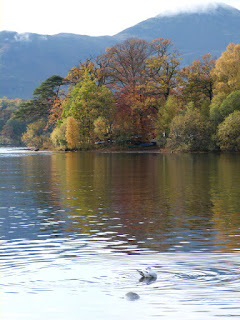 |
| Derwentwater in Autumn |
 |
| Derwentwater in Autumn |
In my previous blog I wrote about autumn colours, senesence and why leaves change colour so I thought in this blog I would write a little bit about mist and fog and temperature inversions. We have had some stunning sunsets and moon rises coupled with some mist and fog resulting in some beautiful scenes. I haven't managed to capture all of the scenes - but I have seen a bit of it from the office window!
 |
| Keswick - autumn colour |
Mist is basically water vapour. Tiny little water droplets form due to differences in temperature between the cold air and the warm land or water body. As the air gets cooled it causes condensation. The mist and fog that we see in the valleys is basically a pocket of cold dense air that has 'fallen' there and the warmer air is passing over it.
 |
| Mist rolling through the valleys |
At night the land and water bodies lose the warmth they have gained fromt he sun during the day and cool down. As the air comes into contact with the cold land, it also gets cold. Cold air cannot hold as much moisture as warm air and so condensation and fog forms. As the day warms up so does the mist and fog causing the water droplets to turn back into water vapour.
 |
| Mist and autumn colour |
 |
| Eerie looking trees in the mist |
All of these weather concepts result in some beautiful landscapes for us. As the year goes on we start to get some more interesting weather phenomena such as frosts, snow and ice not to mention wild rain and wind! I will be blogging some more about all of this as the season pass...
There is more detail about fog on the Met Office learning page - full of info for natural world nerds like me!
No comments:
Post a Comment